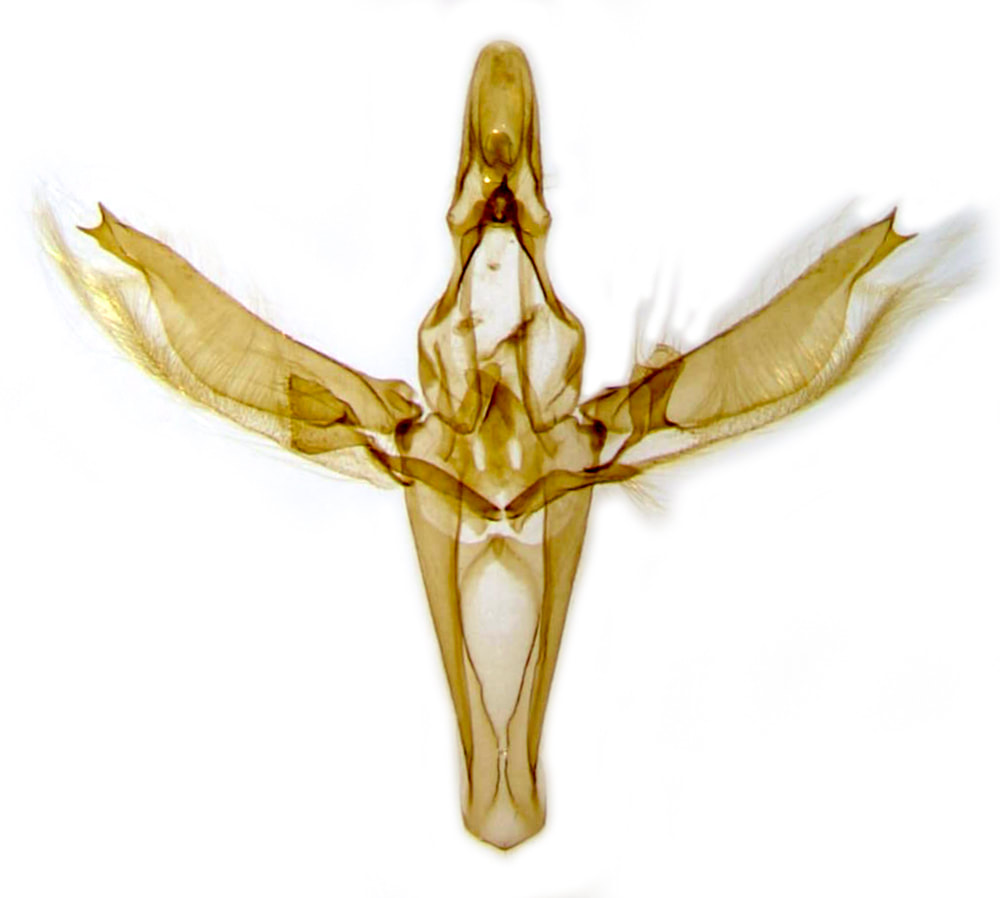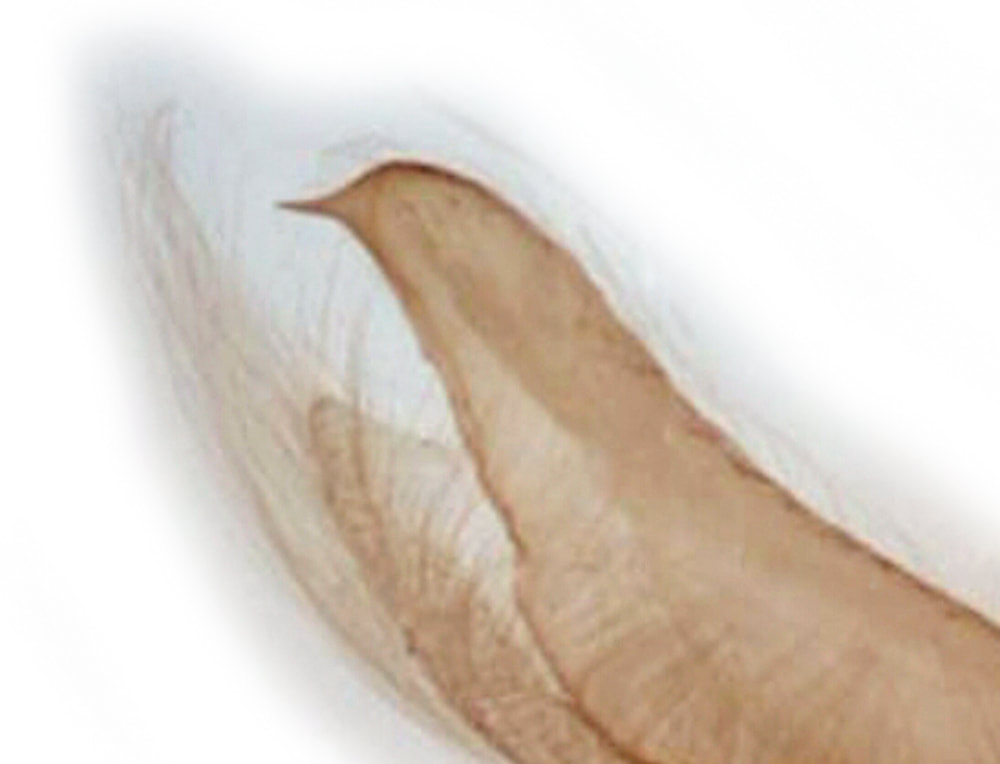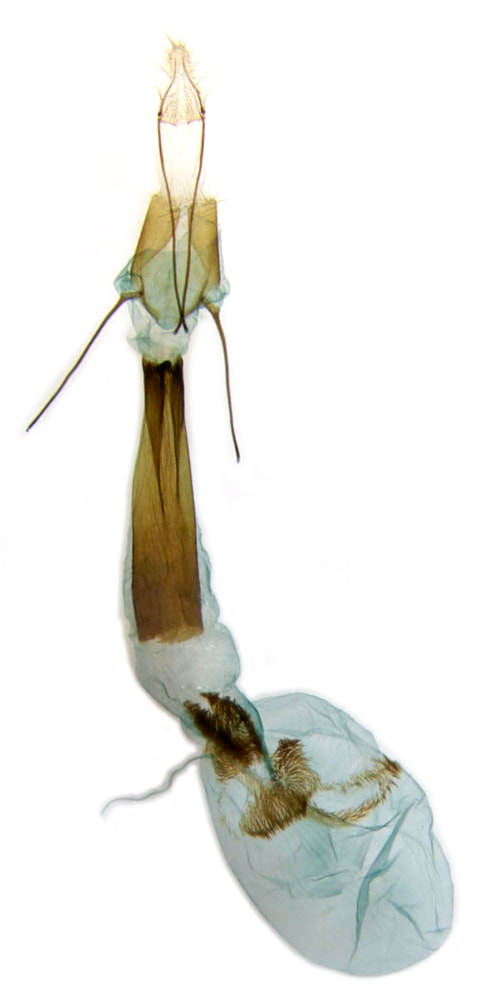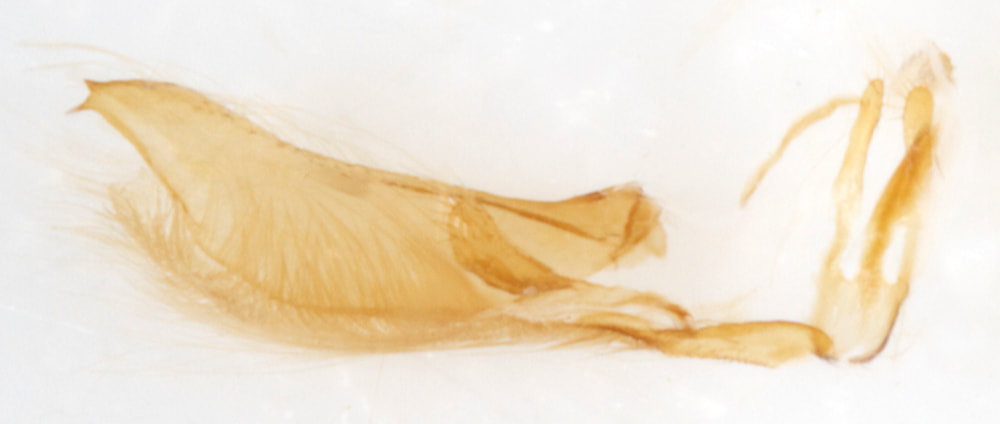Dioryctria |
References:
Goater; British Pyralid Moths, 1986
Sterling & Parsons, Filed guide ot Micro-moths, 2012
Entomologists Record vol 118, p194, 2006 - Male genitalia
Parsons & Clancy, 2002 in Atropos issue 15 describes D.sylvestrella
Goater; British Pyralid Moths, 1986
Sterling & Parsons, Filed guide ot Micro-moths, 2012
Entomologists Record vol 118, p194, 2006 - Male genitalia
Parsons & Clancy, 2002 in Atropos issue 15 describes D.sylvestrella
The 4 British Dioryctria species are very similar.
D.sylvestrella should be identifiable on the basis of the smoothly curved postmedian line and distinctive genital features in both sexes.
D.schuetzella may be identifiable on the basis of relatively broad white crosslines and a pale spot on the hindwing
D.simpliciella and D.abietella are very similar and may not always be distinguishable from each other
D.sylvestrella should be identifiable on the basis of the smoothly curved postmedian line and distinctive genital features in both sexes.
D.schuetzella may be identifiable on the basis of relatively broad white crosslines and a pale spot on the hindwing
D.simpliciella and D.abietella are very similar and may not always be distinguishable from each other
External Features
Size: D.sylvestrella averages the largest of the group and possibly the largest individuals (fw 16mm+) can be assumed to be this species. But there is considerable overlap, and material I have examined leads me to believe that the quoted ranges are not entirely correct.
Size (mm) |
wingspan (Goater) |
wingspan (UKmoths) |
forewing length (Sterling & Parsons) |
forewing length (my specimens) |
D.sylvestrella |
- |
28-35 |
13-17 |
11.6-13.0 (2) |
D.schuetzeella |
26-28 |
~26 |
10-13 |
- |
D.simplicella |
24-30 |
21-30 |
11-14 |
11.2-13.0 (4) |
D.abietella |
27-33 |
26-32 |
12-15 |
12.4-14.3 (4) |
Forewing
Features of the postmedian line and the discal spot may lead to the correct identification.
D.sylvestrella has a smoothly curved postmedian line; it is more irregularly dentate in the other 3 species
D.simplicella has a relatively obscured discal spot; it is relatively bold in the other 3 species
D.schuetzeela is said to have noticeably broader white crosslines than the other 3 species
D.abietella lacks the "distinctive" features mentioned above.
The forewings below belong to the same individuals as the male genitalia below
Features of the postmedian line and the discal spot may lead to the correct identification.
D.sylvestrella has a smoothly curved postmedian line; it is more irregularly dentate in the other 3 species
D.simplicella has a relatively obscured discal spot; it is relatively bold in the other 3 species
D.schuetzeela is said to have noticeably broader white crosslines than the other 3 species
D.abietella lacks the "distinctive" features mentioned above.
The forewings below belong to the same individuals as the male genitalia below
Forewing |
postmedian line |
discal spot |
D.sylvestrella |
smoothly curved with single dentation convex to termen |
bold, quadrate |
D.schuetzeella |
broad, dentate |
bold, ~reniform |
D.simplicella |
dentate |
relatively obscure, ~ovoid |
D.abietella |
dentate |
bold, ~reniform |
Hindwing
D.scheutzeella has a diagnostic, indistinctly outlined, triangular pale spot on the hindwing near the termen.
D.scheutzeella has a diagnostic, indistinctly outlined, triangular pale spot on the hindwing near the termen.
Male genitalia
According to Goater "D.abietella and D.simplicella are very similar and variable; D.sylvestrella is distinct"; however he doesn't either illustrate or describe the differences. Moth Dissection has images of D.sylvestrella, D.abietella and D.simplicella and the Entomologists Record paper illustrates these three species. There is an image of the male genitalia of D.schuetzeella at Norfolk Moths.
The Moth Dissection images of the aedeagus show basal and apical groups of cornuti. In D.abietella and D.simplicella the basal cornutus is particularly strong and accompanied by a small group of long fine cornuti; the basal cornutus is much weaker in D.sylvestrella. It is unclear whether there are any consistent differences in the apical group of cornuti between D.abietella and D.simplicella, however in D.sylvestrella these appear to be shorter, weaker and distributed more haphazardly and the aedeagus lacks any basal cornuti.
See caution at bottom of this page
According to Goater "D.abietella and D.simplicella are very similar and variable; D.sylvestrella is distinct"; however he doesn't either illustrate or describe the differences. Moth Dissection has images of D.sylvestrella, D.abietella and D.simplicella and the Entomologists Record paper illustrates these three species. There is an image of the male genitalia of D.schuetzeella at Norfolk Moths.
The Moth Dissection images of the aedeagus show basal and apical groups of cornuti. In D.abietella and D.simplicella the basal cornutus is particularly strong and accompanied by a small group of long fine cornuti; the basal cornutus is much weaker in D.sylvestrella. It is unclear whether there are any consistent differences in the apical group of cornuti between D.abietella and D.simplicella, however in D.sylvestrella these appear to be shorter, weaker and distributed more haphazardly and the aedeagus lacks any basal cornuti.
See caution at bottom of this page
Male genitalia |
apex of valva |
basal cornuti |
D.sylvestrella |
broad, sinuate with a short hook-like spine |
small, diffuse |
D.schuetzeella |
pointed, but not notched, hooked or spined |
absent? |
D.simplicella |
narrow, notched |
1 strong, several fine |
D.abietella |
narrow, rounded with a spine |
1 strong, several fine |
In the images of the aedeagus with the vesica everted, the basal cornutus becomes apical
Female genitalia
Images are shown for all four species at Moth Dissection. I cannot see any difference between D.simplicella, D.abietella and D.schuetzeella; D.sylvestrella appears to be distinct in that the posterior cluster of spiny signa is separated from the sclerotised corpus bursae by a clear area at the junction of ductus bursae and corpus bursae - in the other 3 species this posterior cluster is in contact with the sclerotised ductus bursae with no clear area.
Images are shown for all four species at Moth Dissection. I cannot see any difference between D.simplicella, D.abietella and D.schuetzeella; D.sylvestrella appears to be distinct in that the posterior cluster of spiny signa is separated from the sclerotised corpus bursae by a clear area at the junction of ductus bursae and corpus bursae - in the other 3 species this posterior cluster is in contact with the sclerotised ductus bursae with no clear area.
Caution
|
This individual has a bold discal spot (favouring D.abietella over D.simplicella). On initial examination of the valval apex it appeared rounded with a spine (apparently confirming D.abietella) but on laying the valva flat the apex is clearly notched (suggesting D.simplicella).
Firstly: caution - the two spine components of the apical notch may not sit naturally in the same plane. Secondly: Parsons and Clancy warn that the male genitalia of these two species are similar and variable and some individuals may not be assignable to species. Thirdly: this specimen has a fw of 15.5mm - larger than quoted ranges for either of these two species - but again favouring D.abietella over D.simplicella |























